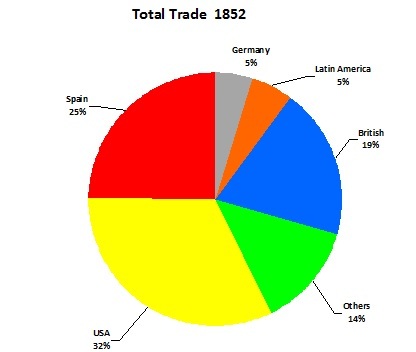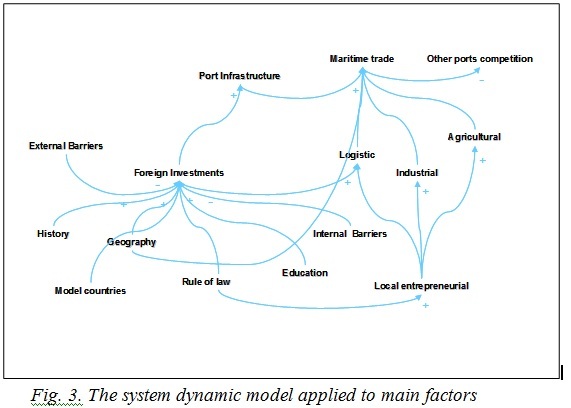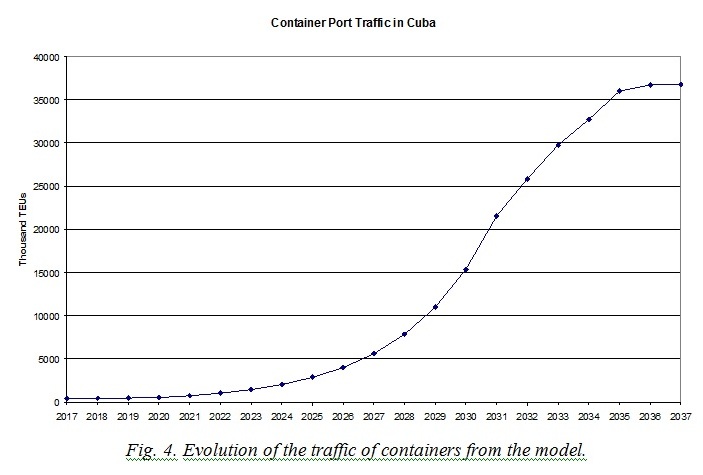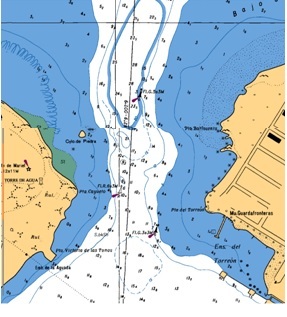BISAC NAT010000 Ecology
BISAC NAT045050 Ecosystems & Habitats / Coastal Regions & Shorelines
BISAC NAT025000 Ecosystems & Habitats / Oceans & Seas
BISAC NAT045030 Ecosystems & Habitats / Polar Regions
BISAC SCI081000 Earth Sciences / Hydrology
BISAC SCI092000 Global Warming & Climate Change
BISAC SCI020000 Life Sciences / Ecology
BISAC SCI039000 Life Sciences / Marine Biology
BISAC SOC053000 Regional Studies
BISAC TEC060000 Marine & Naval
The change in the present conditions and the end of the United States embargo to Cuba is expected that is going to produce a big deal transformation in the whole production system. Cuba as an Island is bound to use the sea as the main way of transportation. That means that a huge increase in the use of the coastal waters as well as in the lands that will be occupied by the new ports facilities. This paper will deal with a modelization of the future development of the maritime transport and the effect that it will cause to the population and the environment. Different scenarios are going to be considered and an assessment of the affection of each one is going to be analyzed. The aim is to balance a legitimate future development that the population deserves with the preservation of the enormous value of the Cuban natural maritime assets.
Ports, transport, development, pollution
I. The future
Sciences and Techniques have the prediction of the future as one of their most pursued goals and a lot of efforts have been devoted to it. In the case of Cuba there are many uncertainties about the future, but at the same time there are a huge number of possible scenarios that could be taken into consideration. When the environment of a country evolves in a more or less continuous way it is possible to use past data and their natural evolution for forecasting the future. But in this case it seems that the continuity has been broken abruptly and a new and different situation is going to emerge. This change in the conditions of Cuba were expected and desired by many, but the characteristics of the future roadmap remains as a great incognita.
There are several conditioning that could drive the future, but it is not easy to discriminate the role and the relative weight that each one is going to play. The aim of this work is not a deliberation about the history or the political conditions, or is it? Really it is focused on the impact that the future development could cause to the life conditions of the people or if it is preferred a holistic approach to the environment. It is possible to use some indicators for making an assessment of those conditions as the level of pollution, the amount of spillage, the NOx, or the GDP. But those parameters are strongly conditioned by decisions that will be determined by what is known as the political ones. Decision makers use to be seen, in many cases, as irrational and unpredictable persons that are not under the umbrella of the rationale as other human beings. Of course, there are many decisions that are out of the scope of the science, and that a technocracy has also many risks, specially that one that besides on the authority of a technocrat with the old vicious of those politicians. But there are many decisions that could be taken with the strong support of the engineering or scientist knowledge. Those tools have to be employed to procure better conditions for the present and future generations. It is sometimes difficult to demonstrate, but though there are many contradictions, the dialectic of the history seems to guide to a better world, and the task could be to anticipate the future in order to be prepared for achieving the best conditions that facilitate that transition.
The end of the embargo from United States to Cuba will broke the isolation that have suffocated the economy and the life conditions of the people for tens of years. But it is necessary to be prepared for such event and to envisage the possible scenarios for choosing the best alternatives.
Maritime transport is almost inexistent in Cuba if it is compared with neighbor countries, and as well as is compared with what happened along the Cuban history. So it seems to be unavoidable that the maritime transport will be increased in a really dramatic way. And that will carry consequences in many ways. The data that drive to those assumptions, the lessons learned from other countries with some conditions that could be comparable with those in Cuba, and the different scenarios and their consequences are going to be addressed in this paper. Development is not for free and sometimes the toll to be paid is so high that it could jeopardize the very development. It is crucial that the construction and exploitation of the maritime facilities respect such valuable environment as the Cuban coasts. This is one of the main assets that Cuba has; it could be one of the countries in the World that, due to its shape, has a greater relationship between the length of coast and its total area. It is a fantastic source of wealth if fisheries, tourism, maritime transport, and the spiritual enjoyment of gazing are considered.
There are plenty of aspects that could be considering for the modelization of the future conditions. Some of them are going to be explained, and how it could be considered. Among them first is the very special location of the island. History also could be considered, though with a long interruption in its normal flow. The material and human resources will play also a decisive role. Some helps from other countries experiences are going to be considered. With all this information a dynamic system analysis could give some guidance for different situations. Finally the impact of each one is going to be considered and a package of possible measures to avoid the damage that all this development could cause to the environmental conditions as well as the perspective of a future that could bear such changes.
II. The geography and the history
Geography determines in a very significant way the conditions of a country. Human beings are also capable to change the physic constraints, although in the case of Cuba what actually happened was that they created an intangible barrier. So it is possible that accidents [1] can change the history. The combination of both parameters apparently has determined the life in Cuba in the past. But history and geography are so stubborn in such way that if a longer period is considered they would be able to return to the natural conditions [2].
The Geography
Cuba has a very special location in the Caribbean and in one of the most transited routes of maritime traffic of the World. The proximity to United States, the first economy of the World, is also a distinguish condition.
Location is one of the most important parameters to be considered in any production process. The transport of the products to the clients or consumers plays a decisive role in the decision of the localization of any production or distribution center.
In this analysis the geography is going to play two roles. One is the study of physical conditions that could determine the location of the production or distribution centers that in a decision-making process will help to choose the most rational alternative. Another aspect is the analysis about the consideration of how some locations have been chosen in the past.
Although the initial location may be due to many causes some principles of the economy of resources and rationality invite to assume that decisions have been taken with a certain intellectual rigor. But it must be admitted that in any decision process not always the selected solution is seemingly the optimal, taken into account specific criteria. Moreover not only the analysis but also the real situation is extremely changing throughout history. The history of economics is precisely the succession of equilibrium situations demonstrating that use to break sequentially creating new situations. These breaks may be more or less abrupt in the form of crisis or economic "boom". In this case two separate analyses will be performed. On the one hand are the description and consideration of the geography of trade centers of production and demand for distribution services, as well as the consideration of the fundamentals that support them, and that the current condition nowadays. On the other is the projection into the future of a port infrastructure that yields the opportunity to a country as Cuba to compete with other countries. The consideration of geography in the world of transport has always played important role, but it has not been subject of academic analysis or modelization until recent times.
Traditionally demand and production were the basis of the economic equation, but now they are strongly affected by transport and distribution activities [3]. The transportation cost is quite important, but transportation time is increasingly becoming a determinant factor. Clearly, transport cost is important but the consumer demand for shorter delivery intervals is crucial in the logistic activity.
The geographical location of Cuba could allow offering a low cost of transport due to the proximity to numerous points of demand. Also its capacity to lower many costs, and the rapidness in delivery times could help such development. In that sense it could be envisaged the combination of a multimodal system in combination with air transport as the end of a logistics process that could take place there.
Figure 1 shows how is the maritime traffic in the area surrounding Cuba in a randomly selected day. There are two aspects that can be considering. The first one is the intensity of the traffic in that area. If a comparison is made with other parts of the World (Table 1), the amount of ships is one of the highest in the World.

Fig. 1. Maritime traffic in the zone in a typical day. Source Marine Traffic
Table 1. Maritime traffic in a random day.
|
Zone |
Num. of ships |
|
Florida, Gulf of Mexico, Caribbean and Panamá |
6.254 |
|
Central northern Europe |
9.983 |
|
Mediterranean |
4.238 |
|
China, Japan, Korea and Hong Kong |
11.456 |
|
Southeast Asia |
2.500 |
|
Source: Prepared by Author and Marine Traffic |
|
But it is also very interesting to notice the degree of isolation that Cuba suffers. All the continental and island countries have several ships in their coasts countries, but not Cuba. There could be other type of reasons for not being accounted, but the real traffic of ships in Cuba is really scarce.
So that means that the potential of Cuba from the geographic point of view is enormous. The possibilities of acting as a hub for transshipment from routes that comes from all the continents or form different ports of USA, Canada or the Americas are very realistic. If the economy of Cuba awake because the opening of the USA markets the production of Cuba and the need of equipment and goods will be another source of demanding maritime transport.
If the barriers that close the possibilities of the commerce with USA fall down, jointly with the aperture and reform of the inside economic system, the success of an improvement of the economic conditions of the people will be noticed in the short term. For such purpose the contribution of the development of the maritime transport, as well as the port infrastructures are imperative.
The History
In this work a review through of Cuban history has been made. It could be considered that some kind of battle has taken place between the productive or extractive activity and the trade activity. Agricultural, industrial or extractive activities have alternate or sometimes coexist with the commercial activities. But in all those situations the maritime transport was the support of all of them. Is only in relatively last times, when ports in Cuba lost their traditional activity. Havana has been the center of the commercial activity, while Santiago and the rest of the island devoted to the production or extractive ones.
At the beginning of Cuba as a colony of Spain in the XVI century, extractive activity was the most important one. It was abandoned soon as the possibilities in the continent, Viceroyalties of Nueva España (Mexico) and Perú were much more promising. But in not many years Cuba assumed the leadership in services to the fleet system. It was in some way the starting point of the hub system. All the ships coming from Veracruz in Mexico and from Cartagena de Indias in Colombia assembled in Havana. There were two reasons; one that from Havana was easier to take the Gulf Stream that facilitates the journey to Europe. And secondly because security reasons. The cargo was so valuable that it was exposed to the assault of pirates. As many ships, that were a mix of cargo and war ships, travel together there were less opportunities to be attacked by pirates or other countries ships.
In addition, other circumstances increased the role of Havana. As the ships carried a valuable cargo, but were generally low volume, and not very high weight, there were an opportunity to refill the capacity with other goods.
Havana became a city of multiple services. On the one hand it provided shelter to possible inclement weather allowing the fleet for awaiting better conditions. On the other Havana provide security against enemy attacks, and finally providing shelter, food, repairing ships and navigation instruments. That means the whole attachments that the whole fleet may need. A new industry dedicated to fleet services which served as attraction to new immigrants, from carpenters, artisans and merchants of all kinds. As Moreno Fraginals [4] indicates the following equation:
Geographical situation + production + defensive Infrastructure
They made Havana a privileged enclave in maritime traffic.
Later the production of sugar cane, coffee replaced the services to the fleet, but increasing the commercial activity in the island. In the middle of the 19th century the number of movement of ships per year in Havana Port were almost 3000 [5].

Fig. 2. International trade in Cuba. 1852 Source: Balanza general del comercio de Cuba en 1852. (Havana 1853)
The independence does not change so much the previous status, and was the revolution in 1959 the great change in the Cuban trade. The embargo and the rupture with the most important partner of Cuba was a radical change. The new relationship with the URSS, the COMECON countries and China initiated a new period in Cuba commercial business.
The worst for Cuba was when the URSS and other countries changed their regimes as well as the end of the commercial agreements under the COMECON. Unlike what happened in other countries as China, Russia, Poland or Vietnam, that established normal trade relationships with USA, the embargo with Cuba is still alive.
Today the economic activity in Cuba is stagnated, especially if it is compared with other countries of the ancient communist bloc, Vietnam or China. It is extremely important that the hope of the recent openness could drive to a normalization of the relationship between Cuba and USA, as well as the end of the embargo. Nevertheless, more changes are needed specially giving new opportunities to foreign investments and the support for new Cuban entrepreneurs. Those requisites are crucial for the development of the maritime transport.
III. The model
Taking into account the geography, the history, the present conditions in Cuba and the lessons learned from other ports or countries as Shanghai, Shenzhen in China, Tangier in Morocco , Kingston in Jamaica or the ones in the north of Europe, an approach was selected for trying to forecast the future. Some scenarios have to be taken into account because there are so many unknown variables.
It was considered the possibility of many different tools, but in the end it seems that the system dynamics could be the one that could fit better to this difficult analysis. It has the possibility to assess the sensitivity of different parameters and to use different evolution models for each parameter. In a schematic way is going to be presented the model for the possibility of a future development of the port of Mariel as the paradigm of the port system in the island. The scheme is divided in two parts, one for the port exploitation, and the other one for the environmental consequences of the previous results.
The Economic model
Applying the system dynamic model to the conditions of Cuba it is possible to take into account the most important factors that could have an especial weight in the future development of the maritime transport (Fig 3). Some of them as history could have only an initial influence for the decision making process for foreign investments. One of the most important are barriers as the end of the embargo. The facilitation of the authorities for foreign investments in port construction or concessions is crucial due to the importance of international operators in the maritime traffic. Those measures have to be accompanied with the encouragement for the creation of small and medium companies that will support the activities of the international operators.
The participation of the individuals in the economy will be crucial for such development. The possibilities of improving the production of agricultural products more or less transformed is a tremendous opportunity for Cuba. But it needs the participation of the Cuban people and their initiative. Education is one of the most valuable assets of Cuba. The high level of the education will be very helpful for achieving a place in a competitive market.
The pace of the changes is difficult to forecast, but it is inevitable that sooner or later, but no too late, are going to take place.

In Fig. 4 a result of the model shows the prediction in the future traffic of containers for Cuba.

The Environmental model
The transformation of ports and the increasing of maritime traffic may cause plenty impacts in the environment. The Cuban authorities [6] are concerned with the Mariel Special Development Zone and try to promote the creation of a favorable environment in the area, from the attention to differentiated quality and diversity of common basic services and to the educational, cultural and sports activities. They has a commitment to comply and enforce the rules relating to environmental protection, the removal or mitigation of pollution, soil conservation, the water resources, marine areas, flora and fauna, as well as control animal and plant health.
Nevertheless it is necessary to learn from other countries and the problems they are experimenting with environmental issues related to the construction and all the activities in the ports as well as the hinterland where the port has some influence.
There are good documents and experiences from other ports that could be used in Cuba for the new port development [7].. Mariel is going to be the reference port of Cuba: It is an existing port, but will need some changes for facing the new development of maritime transport.
So in this case there are few alternatives in selecting the sitting, but if some enlargement are going to be projected is necessary to address the environmental and socio cultural impact, as the transportation of construction materials, the demand on labor resources and the stresses on fisheries, water and air quality.
New demands form the new larger ships (deep water ships) will drive to the need of dredging (Fig.5). That means changes in water quality, increasing of BOD (biological demand of oxygen), and suspension of toxic sediments, turbidity and others that has to be minimized. There are many measures that could alleviate those impacts. Also the dredged materials have to be treated properly.

Fig. 5. Entrance to the Port of Mariel
Special care has to be taken with quarries, borrow pits as well as asphalt and concrete plants. Closures and the treatment of waters have to be considered.
Other impacts should be assessed as the potential damage that could be inflicted to the shoreline, wetlands, coral reefs, fisheries, bird life, that represent a very sensitive part of Cuban coasts.
Operations at the port facilities could consider the risk of chemical spills, noise and air pollution. Surveillance has to been carried out on the storage of waste and the avoidance of dumping into the land or in marine waters. It is necessary to provide the treatment of sanitary wastewater, the ships garbage, the ballast water, oil, tank washing and others according to the MARPOL rules.
Addressing some details, it could consider the air emissions from Oxides of nitrogen (NOx), oxides of sulphur (SOx), particulate matter (PM). There are also greenhouse emissions as Carbon dioxide (CO2) and Methane (CH4) and Nitrous Oxide (N2O).
In the waters moreover the previous mentioned, the biological pollution by pathogen microscopic organisms, paints or oil spillage has to be taken also into account.
Soil pollution from the maritime transportation sector is mainly linked to the terrestrial activities in port areas. There are multiple sources of soil pollution in port areas: discharge of oil on the soil (from the vehicles and fuel deposits), spill of chemical from demolition of ships; and emissions of SO2, NOx causing acid rain and consequently, soil acidification. However, the main impact of ports on soil is erosion. Because the presence of a port modifies the natural coastal sediment transport, it causes erosion. This can produce a degradation of natural impact and harm the local biodiversity. Secondly, it can cancel out portions of land that could be used for recreational or productive uses.
The impacts on biodiversity could be attributed mainly to the air emissions, dredging and the transfer of ballast water. The economic valuations of port-related biodiversity loss although is substantial, appears difficult to valuate economically unless the loss regards species, has a value on the market (fishes and seafood).

There is other important impact over the human beings. The process of change has to be deployed in a very respective way to the people and their customs, culture and the way they have performed for many years. Not everybody will be prepared for the change, so it is necessary to arbitrate adaptation measures that allow all the citizens to deserve a place in a better country. Transitions from a centralized economy to one more opened can be tough for many people and it is possible that they will be not able to embrace those changes. This is a very sensitive issue and lessons from other countries have to be considered for avoiding errors and human suffering.
1. Krugman, P. The role of geography in development. International regional science review, v. 22, n. 2, p. 142-161, 1999.
2. Braudel, F. Histoire et Sciences sociales: La longue durée. Annales. Histoire, Sciences Sociales, 1958 13(4), 725-753. Retrieved from http://www.jstor.org/stable/27579986
3. Rodrigue, J. Challenging the derived transport-demand thesis: geographical issues in freight distribution. Environment and Planning A, v. 38, n. 8, p. 1449, 2006. ISSN 0308-518X.
4. Moreno Fraginals, M. Cuba-España España-Cuba : historia común. Barcelona : (sp): Crítica, 2002. ISBN 84-8432-319-6
5. BU MARCHECO, J. V. 100 Questions and Answers about the Mariel Special Development Zone in English - Cuba Business News - Havana Journal. 2013. Retrieved from http://havanajournal.com/business/entry/100-questions-and-answers-about-mariel-special-development-zone-in-english/ . Access : 8/15/2015
6. Franklin W. Knight. Origins of Wealth and the Sugar Revolution in Cuba, 1750-1850. The Hispanic American Historical Review, Vol. 57, No. 2 (May, 1977), pp. 231-253Published by: Duke University PressStable URL: http://www.jstor.org/stable/2513773
7. MERK, O. The Competitiveness of Global Port-Cities: Synthesis Report. Organisation for Economic Cooperation and Development (OECD). Paris, p.0_1,1-2,7-183. 2013







